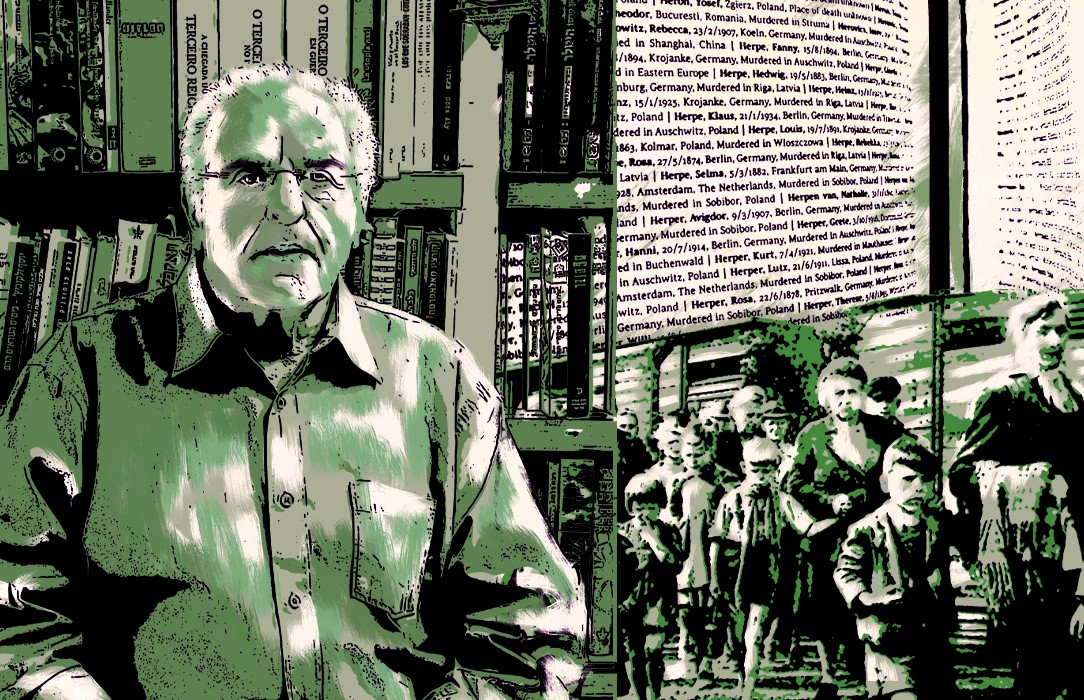In an article on the eradication of smallpox in Brazil, Gilberto Hochman analyzes the multiple factors behind the end of an epidemic
| By:Silmara Mansur/iStock. |

By Karine Rodrigues
When and how will Covid-19 disappear? This is the question that is asked worldwide after the worst phase of a pandemic that has already caused the death of millions of people. Developed in record time, vaccines against Sars-CoV-2 allowed the world to breathe again, but the virus remains active because the end of a disease depends on a variety of factors. And not all of them can be explained by Medicine.
Without a nationally coordinated vaccination and information campaign, including mobilization of society, the disease cannot be controlled, let alone eliminated
“The end of an epidemic is established not only in terms of the existence of a vaccine, an effective therapeutic solution, a drop in the rate of contagion, the attainment of immunity in the population or a drop in the number of cases and deaths. It also depends on the way in which societies perceive the epidemic experience at the moment, how they jointly remember past epidemics, how they understand and imagine that social life, which was interrupted for them, was or will be re-established and by the political and economic interests involved in declaring this end," highlights Gilberto Hochman, Professor of Political Science, in an article in the dossier on Covid-19 of the Revista Brasileira de Sociologia.
 |
| Gilberto Hochman. Photo: COC/Fiocruz. |
In the text, in which he analyzes the end of diseases in local contexts, for example the Smallpox Eradication Program (1966–1973) in Brazil, the researcher from the Casa de Oswaldo Cruz (COC/Fiocruz) describes the background behind the official announcement of the eradication of smallpox in the country, which occurred in August 1973, during the military regime. The investigation carried out using primary and secondary sources sheds light on the multiple dimensions of a public health conquest against a disease that had been a threat for centuries, with lethality reaching 30% in its most severe form.
“This is not a debate exclusive to epidemiologists and physicians. Historians and social scientists have long established that diseases and epidemics are not strictly biological phenomena,” notes Hochman.
An infectious viral disease transmitted via the respiratory tract, with accounts dating back 3,000 years and hundreds of millions of deaths, throughout the 20th century smallpox was endemic in the Americas, with epidemic outbreaks of its most severe form in parts of Africa and Asia. From a biomedical point of view, the fact that humans are the only hosts of the disease, the existence of a single serotype and the permanent immunity conferred by the infection and the vaccine contributed to its disappearance, announced by the World Health Organization (WHO) on May 8, 1980. But other factors are part of the story of the only human disease intentionally eradicated so far.
Constantly cited during the Vaccine Revolt in November 1904, when obligatory immunization was the target of disputes and conflicts in Rio de Janeiro, then the federal capital, smallpox existed in Brazilian much longer, with records dating back to the 16th century, and continued to frighten the population in its most severe form until 1930, when the milder form of the disease began to prevail. It then became neglected on the health agenda until, in the mid-1960s, given the large number of cases in countries like India and Brazil, which had the largest number of cases in the Americas, the WHO launched a global campaign to try to eradicate it.
The importance of national and international cooperation
The initiative provided endemic countries with the opportunity to receive human and financial resources to fight the disease with the objective of preventing the importation of cases to those countries already free of smallpox. Despite the Cold War, a great cooperation movement mobilized financial and technical resources to reduce cases to zero on a global scale. In the face of international pressure, Brazil created the Smallpox Eradication Campaign (CEV) in 1966, joining the worldwide movement led by the WHO.
The lack of coordination at the national level in the response to Covid-19 and in vaccination contrasts with the coordination and mobilization of the Smallpox Eradication Campaign in the midst of the military regime
“The campaign was seen by the military regime as an opportunity to obtain international resources for public health and present positive results that could be used for comparison with the democratic government it had overthrown,” writes Hochman in the article, adding that material and human resources were provided by the United States and Canadian governments, the Pan American Health Organization (PAHO/WHO) and Rotary International.
What was seen in Brazil then was enviable mobilization from a current point of view. In order to eradicate an infectious disease that had decimated thousands of people over the centuries, political leaders, teachers, military personnel, health professionals and religious groups participated in the call to ensure adherence to vaccination. “Mass vaccinations were performed at popular festivals, pilgrimages, religious gatherings, fairs, popular artistic events, barracks, public schools, airports, bus and railway terminals and large companies during extended hours,” describes the researcher..
Despite the strict legislation to guarantee vaccination, requiring vaccination certificates to receive salaries, enroll in schools and obtain public documents, Hochman notes that the population's response to mass vaccination was not exclusively linked to coercive action and advertising. It was also likely a result of what the researcher calls the “culture of immunization” in Brazil throughout the 20th century, which he also addresses in another article, published in the journal Ciência & Saúde Coletiva. “In a country marked by social exclusion, vaccines, provided free of charge by the State, began to be perceived as a public good,” he explains.
When describing the mass vaccinations carried out 50 years ago in Brazil, during the military dictatorship, Hochman makes a connection with the present day. "The lack of coordination at the national level in the response to Covid-19 and in vaccination contrasts with the coordination and mobilization of the Smallpox Eradication Campaign in the midst of the military regime."
In Henfil's cartoons, a question: Onward, Brazil?
While, on the one hand, the military regime invested heavily in immunizing the population, on the other, it introduced censorship, prohibiting the disclosure of public health problems like the meningococcal meningitis epidemic. During his investigation, Hochman found a solitary, firm voice amidst the excessively patriotic atmosphere and the silence imposed by the dictatorship: cartoons by the cartoonist Henfil, published in the weekly newspaper O Pasquim, in 1971, referred to the persistence of smallpox in the country and to the military government's boastful propaganda, with slogans like “Onward, Brazil” and “Brazil, love it or leave it.”

O Pasquim, n. 92, 8-14/1971. Image: Newspaper Library of the National Library.
"It was a great find. A good-natured critique of the military regime at its worst. Henfil played with the idea that Brazil, world soccer champion in the 1970 World Cup, was champion in smallpox in the Americas. A well-known cartoonist criticizing the military regime and its patriotic slogans: is this the country that is moving forward? I think that it was a rare critique of the government at that time," says the researcher.
Upon receiving WHO certification for the eradication of smallpox on August 25, 1973, the Brazilian government made only a brief official statement, which resulted in little coverage in the press. As they were aware of the uncertainties surrounding the scenario, which extrapolated biomedical and epidemiological issues and involved criticism and mistrust from international organizations, the military wanted to keep the matter quiet, thus trying to lessen the negative effects if the disease had not, in fact, been eradicated.
The silent end of smallpox
"The end of an epidemic or a disease arises from an understanding that involves multiple interests and actors: national and subnational governments, international organizations, scientists, epidemiologists, immunologists, physicians and health professionals, the press and social networks, scientific societies, companies and civil society organizations and the people affected directly or indirectly. One can claim that history and the social sciences provide ways to understand these processes over time and in specific contexts,” emphasizes Hochman in the article.
In his view, the end of an illness, of an epidemic, is contextual. And that is how it must be understood, as a process taking place in time and in space. “Even if you have a virus, a vaccine, everything is the same, the disappearance of a specific virus is a social, political, biological and cultural act,” he says. Asked about the relationship between the eradication of smallpox and the Covid-19 epidemic, the researcher stresses that the process that took place in the 1960s and 1970s shows us that, “without a nationally coordinated vaccination and information campaign, including mobilization of society, the disease cannot be controlled, let alone eliminated.” The lesson is clear.
Translated by Naomi Sutcliffe de Moraes






